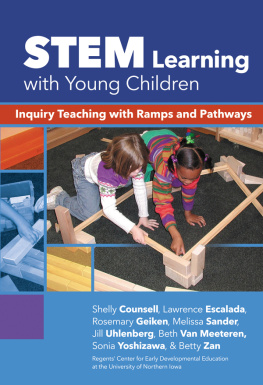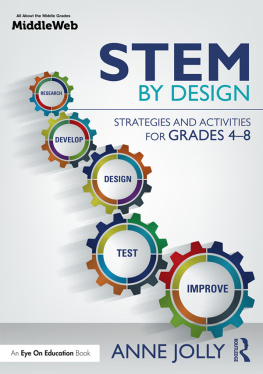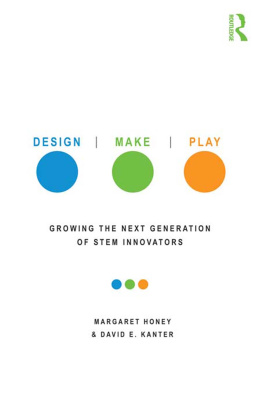
Published by Redleaf Press
10 Yorkton Court
St. Paul, MN 55117
www.redleafpress.org
2013 by Sally Moomaw
All rights reserved. Unless otherwise noted on a specific page, no portion of this publication may be reproduced or transmitted in any form or by any means, electronic or mechanical, including photocopying, recording, or capturing on any information storage and retrieval system, without permission in writing from the publisher, except by a reviewer, who may quote brief passages in a critical article or review to be printed in a magazine or newspaper, or electronically transmitted on radio, television, or the Internet.
First edition 2013
Cover design by Jim Handrigan
Cover photograph Ocean Photography/Veer
Interior design by Percolator
Typeset in Mrs. Eaves XL and Mr. Eaves XL
Interior photographs by Sally Moomaw
Table 3.25 on page 113 was originally published in STEM Comes to Preschool, Young Children 65, no. 5 (2010): 1218. Reprinted with permission from the National Association for the Education of Young Children.
Oil paintings in Activity 7.10 (New Playmate, 2004; Painted Pony, 2007; Firewood, 2009) are by Carol Kelley. Included with permission from the artist.
Library of Congress Cataloging-in-Publication Data
Moomaw, Sally, 1948- author.
Teaching STEM in the early years: activities for integrating science, technology, engineering, and mathematics / Sally Moomaw, EdD.
pages cm
Summary: The foundation for science, technology, engineering, and mathematics education begins in the early years. Teaching STEM in the Early Years provides activities and learning center ideas that seamlessly integrate STEM throughout your early childhood classroomProvided by publisher.
Includes bibliographical references.
ISBN 978-1-60554-253-9 (e-book)
1. ScienceStudy and teaching (Early childhood)United States. 2. TechnologyStudy and teaching (Early childhood)United States. 3. EngineeringStudy and teaching (Early childhood)United States. 4. MathematicsStudy and teaching (Early childhood)United States. I. Title.
LB1139.5.S35M66 2013
372.35'044dc23
2012037237
For Charlie, without whose help there would be no book,
and for Sonya, a true STEM explorer
Contents
I would like to thank my editor, David Heath, for his astute guidance in the preparation of this book, and Charles Moomaw for his extensive technical assistance. I am grateful to Dr. Peter Moomaw for lending his scientific expertise and to artist Carol Kelley for graciously allowing her artwork to be included in this book. I greatly appreciate the participation of Andrew, Ashley, Caroline, Charlie, Emily, Max, Nancy, Peter, Sonya, Tamara, and Vivian, who appear in the photographs.
Sonya decided to build an arena for her toy horses. Her parents made blocks for her by covering half-pint-, pint-, and quart-size dairy containers with contact paper. Sonya carefully stacked four half-pint containers to make a column. Next to this stack of blocks, she built another column by matching new blocks to the four blocks in her original tower. Sonya slid her second stack of blocks about a foot away from the first stack. By repeating this process, Sonya soon had four corner towers for her arena.
Next, Sonya placed a quart-size block on the floor between two of the towers to make a fence. She noticed a gap between the towers and her fence, so she carefully pushed the towers closer together until they touched the fence block. Sonya repeated this process for two additional sides of her arena but used a pint-size block on the fourth side to allow space for an entrance. Delightedly, she moved her horses through this opening into the arena.
Sonya now prepared to add a roof. Running into her fathers office, she found a clipboard and brought it back to her building area. Sonya attempted to lay the clipboard across the columns, but it fell into the arena. Frustrated, she looked around her room and noticed a doll blanket, which she draped over the columns of her building. The blanket was large enough to make a roof, but it sagged in the middle. Dissatisfied with the result, Sonya continued to look around her room. In the closet, she found a square box lid from a game. Much to her delight, the box lid fit almost perfectly across her columns. Daddy, Sonya called. Come see what I made.
Sonya and her father discussed the arena. I want to e-mail a picture to Grandma, Sonya exclaimed. Shell like my arena. Sonyas father handed her his smartphone, and she took a picture of her building. He helped her text a message, and together they sent it, along with the photo, to Grandma.
T his vignette about Sonya encompasses the four disciplines of STEM education: science, technology, engineering, and mathematics. It also illustrates how childrens play can provide fertile ground for learning in each of the STEM disciplines. Through her block building, Sonya experimented with balance, can support and extend childrens knowledge in these critical areas by recognizing the four disciplines of STEM education in the play experiences of children.
INTRODUCTION TO STEM EDUCATION
The acronym STEM originated with the National Science Foundation (NSF) . STEM refers to NSFs education-related programs in the disciplines of science, technology, engineering, and mathematics. Some educators regard STEM as any of the individual STEM disciplines. On the other hand, many others require that some, if not all, of the disciplines be integrated in order to receive STEM designation (Carnegie Mellon University 2008). In this book, STEM education indicates integration of at least two of the STEM disciplines within a curricular activity.
In recent years, STEM education has become a focus of attention in the United States for several reasons. First, U.S. students continue to trail their peers in many developed countries in science and mathematics, as reported by the Trends in International Mathematics and Science Study (National Center for Education Statistics 2009). Second, there is concern that the United States is not adequately developing students in the areas of technology, engineering, science, and mathematics. In a recent report to Congress, the United States ranked twentieth internationally in the number of students who received degrees in science and engineering (Kuenzi 2008). Third, application of content knowledge from STEM disciplines is increasingly required in jobs at all levels. Individuals must process information from STEM areas to make informed societal decisions, such as evaluating conflicting political statements on global warming. Finally, STEM education has been linked to scientific leadership in the world and to economic growth (National Research Council 2011).
The foundations of STEM education begin in a childs early years. Recently, there has been a surge of interest in early childhood mathematics (Clements and Sarama 2007). A substantial body of research attests to the importance of number sense for achievement in school mathematics (Duncan et al. 2007; National Research Council 2009; Starkey, Klein, and Wakeley 2004). In fact, Gersten and Chard (1999) believe that the concepts embedded in number sense are as important to early mathematics learning as concepts of phonemic awareness are to early reading. Understanding of geometry and measurement is also viewed as important and relevant for children in the primary years (Clements and Sarama 2007; National Council of Teachers of Mathematics 2006). Young children are also capable of considerable learning in science during the preschool and kindergarten years (Moomaw and Davis 2010; Moomaw and Hieronymus 1997). Nevertheless, research on science education in preschool and kindergarten is notably lacking. Neither the
Next page









